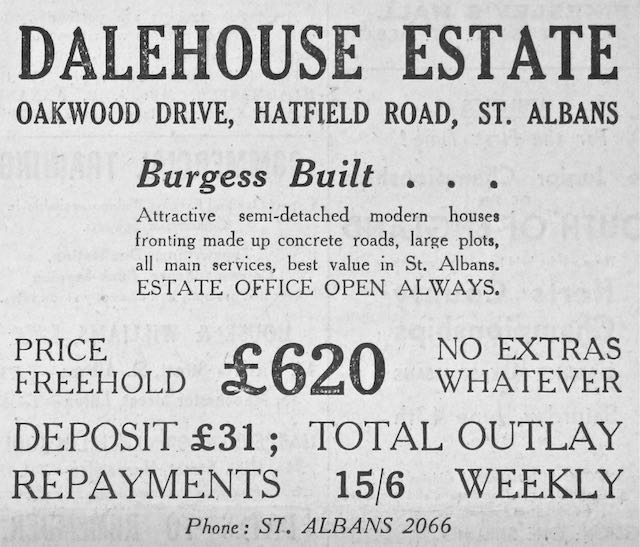We are very familiar with the style of advertisements – in colour of course – and the page layouts in today's Herts Advertisers; and when we compare this with a substantially older style the change hits us as a surprise. Rather old-fashioned; monochrome; plain. But such changes have realistically crept up on readers gradually, and differences would have appeared minimal in the short term. Here is a selection of display adverts appearing in the newspaper before the Second World War.

H C Janes Ltd was one of the key house builders during the 1930s and in St Albans one of the estates the firm was responsible for was the even numbered side of Elm Drive. Appreciating that new homes could be plain and the street scene off-putting when potential purchasers arrived to view, the company arranged for street trees to be planted to soften the landscape. Other builders paid for trees and shrubs to deck the front gardens for the owners' arrival. The next advertisement illustrates how building societies became more popular and encouraged savers "for your future home". The alternative was an "easy terms" equivalent over a number of years. All who aspired to become home owners were offered considerable choice of properties between the wars; the concept of homes to buy rather than homes to let was seen as a family investment.

One building society local to St Albans was the St Albans Permanent Building Society, whose leading light was Cecil Preece. With Cockcroft builders the company maintained premises in Fleetville. It was not unknown to find similar connections with other complementary businesses. In this example the building society's new Spencer Street premises was highlighted as a contract for J T Bushell.
House builders often sought a competitive edge against other nearby builders; one might offer double skinned walls, boarded lofts, driveways or styled front gates and front doors. Burgess builders, having acquired plots along almost the whole of Oakwood Drive (the Dalehouse estate), went even further in providing a choice between bungalows and houses, and also laid a concrete road surface at a time when this was often left for the local authority to manage on behalf of house owners later.
Builders were naturally proud of the individual structures they had won contracts for, and so were ready to list them in their advertising. Bushells, in Catherine Street, were therefore particularly satisfied with their construction of Verulamium Museum in 1939. While we may recognise the external view, the original internal and unextended exhibition area has been much forgotten by residents who visited in its earlier days.
Whereas the majority of earlier homes had been short terraces, J Hammond & Son Ltd, whose base was opposite St Peter's Church, constructed fine well-proportioned semi-detached homes, including along Beech Road. As with many homes of the 1930s period many have since been provided with side and/or rear extensions and any number of loft conversions and enclosed porches, producing a rather muddled street scene compared with the clean complementary designs of the originals.

There was much experimenting with materials and building methods in the 1930s. Concrete attracted the attention of commercial builders in particular and appropriate advertising appeared over a wider area; although even Hoddesdon, home of Bell & Webster, was home territory of the Herts Advertiser in those far off years. We know of at least one local building which was a B&W speciality undertaking government contracts during the Second World War: the Day Nursery (1942) at Fleetville, now Fleetville Community Centre (adapted 1979-82).

Finally, commercial companies occasionally discover there is more to be gained for them and their customers if an existing building can be adapted and upgraded – today we might call it repurposing. Northmet Electric first generated electricity in 1908 from a site in Campfield Road – part of its frontage has also been repurposed. When it came to marketing the sale of electricity and electric goods Northmet Electricity, later to become part of the Eastern Electricity Board, took possession of Ivy House and nearby premises in St Peter's Street north and St Peter's Close. In a period when it was largely the wealthier residents who owned their own properties and who therefore had control of the facilities to make their homes more comfortable, the range of showroom spaces would have made their customers feel "at home". So it is appropriate to observe that in the adjacent residential road of St Peter's Close there were advertisements by Mandley & Sparrow, house agents, at the same time. A prominent photo along a spaciously laid out road was a large detached home of traditional design. No doubt already completely fitted for electricity, both lighting and power. It should be added that the house shown may have been from another location where similar homes had already been constructed.



















